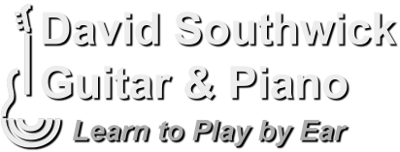Barre Chords
Advantage of Barre ChordsDon’t Give Up
Barre chords are not exactly easy to play. But they are definitely worth the effort — unless you have a guitar with horrible action (the distance between the strings and the frets).
Perhaps the best advice for starting with barre chords would be to use a classical or an electric guitar.
There are several advantages to playing barre chords:
- Play every major and minor chord – Barre chords will minimally allow you to play every major or minor chord with ease.
- Transposes easily – Understanding barre chord theory will allow you to transpose into other keys without much problem.
- Power Chord Positions – Barre chords provide a stepping stone for learning Power Chords. I call power chords “abbreviated barre chords”. Power Chords use only the lowest two or three notes of the barre chord, and sound better than any other chords when played with any distortion effect. (Power chords use the chord formula 1-5. There is no third note, and therefore can be substituted for either a major or a minor chord. A power chord is noted with -5 as a suffix. The G power chord is written “G5”.)
How can I get my barre chords to sound better?
Because barre chords played in the first fret are closest to the nut, the amount of angle between the string and the fretboard is increased. This causes them to be more difficult to play, more difficult to obtain clear sounds.
- Build the muscles in your hands – Don’t stop playing if your barre chord doesn’t sound super clear. It takes time for the muscles in your hands to strengthen, so keep playing even if there is a little buzzing or muting.
- Correct finger form – Making sure your barre finger is straight (not curved) is a help, especially when your thumb is directly behind it allowing more pressure to be applied at the barre finger.
- Drop your wrist – One other important point for barre chords is your wrist. Your wrist should not be behind the neck of your guitar, but below it. This helps with straightening your barre finger and increasing the pressure between the thumb and barre finger.


Hello David,
So I am a beginner player of guitar, I have a steel-string acoustic guitar and I’ve been playing for over a month now being able to play D,A,E,C, G, Am, Em chords very cleanly and now I am learning the barre chord F now I’ve experimented moving down the fret board and playing the F barre chord and it gave different variations of pitch which sounded familiar to some of the major chords I can already play:
Question 1:
is it correct for me to say that barre chords can be able to replace any if not most major chords if you now exactly which barre chord to play and knowing at which fret the fingering positions should be?
Because it turned out that I was trying to emulate a particular song which uses 5 chords for just the intro of the song and I even though I am struggling with my index finger to playing the lower e string and b string with the f barre chord of:
(1st finger-e string and b string-1st fret, 2nd finger -g string- 2nd fret, 3rd finger -a string – 3rd fret, 4th finger – d string- 3rd fret)
I do still get glimpses of the sound f barre chord gives when I do get the sounds of all the strings through single strums allowing me to cover the full intro by moving down the fretboard with the f barre chord finger positioning sounding exactly very much so as it should to the song intro, but of course it would be exact if I can keep a clean sound of all strings with a particular strumming pattern continuously while changing from one scale to another on the fretboard. Additionally, I felt that the barre chord gave more vibrant sound to the intro and accuracy than if I were to play it with the 5 chords required to fulfil the intro. The song intro I was trying to play was of HAIM-Forever.
Question 2:
Do you feel that barre chords can sometimes be a lot more effective to strumming out particular chord progressions over major chords due to minimal chord changes concentrating on efficiency and at the same time also give a more vibrant sound to a major chord being played through a barre chord (if my first question was true)?
Sorry for the long message I look forward to your response, thank you in advance.
Thanks for contacting me.
1) Yes the F barre chord is what I call an E-shape barre chord (it’s patterned after the E-major chord), and as you move it up the fret board it changes by half steps: 1st fret=F, 2nd fret=F#, 3rd fret=G, 4th=Ab, 5th=A, etc… Also if you remove your 2nd finger from the barre shape it changes it to the minor chord.
2) Barre chords have advantages and disadvantages. They can help you visualize how chords work together, and their relationships together vs open chords. And they sometimes can help you switch between chords more quickly. Also, it is easier to transpose a song when you understand/play using barre chords.
At the same time, barre chords are harder to play (and sometimes can seem to strain your hand); and they sometimes don’t sound as bright as open chords because there aren’t anyopen strings being played.
So much of music is subjective, i.e., what do you want it to sound like, or how do you enjoy it… If you like the sound of the barre chords in the song, play it; or if it makes it easier, and that is something you are striving for, use them. If you’re trying to emulate the exact sound of the song, and that’s how they’re playing it, play the barre chords. But all of it depends on what your goals are in playing them.
I play barre chords, open chords, power chords, etc… depending on the need/desire or feel of the moment. Hope this helps and thanks again for your comments/questions!
David
Hello David,
Quick question. I use mainly barre and open chords now.
However, when I watch video performances of the truly great artists i.e. Hendrix, Moore, S.R.V.
they seem to use more chord shapes as opposed to barre chords.
So I’m wondering why?
Is it that when one reaches that level of proficiency, barre chords become to limiting or am I completely wrong on this.
There are so many chord shapes out there, and by nature of the guitar’s design, so many ways to play various chords. The more advanced a player gets, the more chord shapes up and down the fret board they can use, to suit the ‘tone’ they are wanting to achieve.
The advantage to me when teaching barre chords, is to help guitarists see how the chords work together in a particular key. These relationships are not obvious through regular/open chords. A pianist who learns chord theory, can easily visualize the relationships between the chords. A guitarist’s first visualization might be through barre chord theory.
Thanks for your comments and observations!
Jimi Hendrx uses partial barre chords, often using his thumb to play the low E. He also changes the root note of other chords (which also turns these into partial barre). This frees up his 2nd, 3rd, 4th fingers to play his hammer- ons pull-offs and all the other good stuff.
Thanks ‘scratchy’!